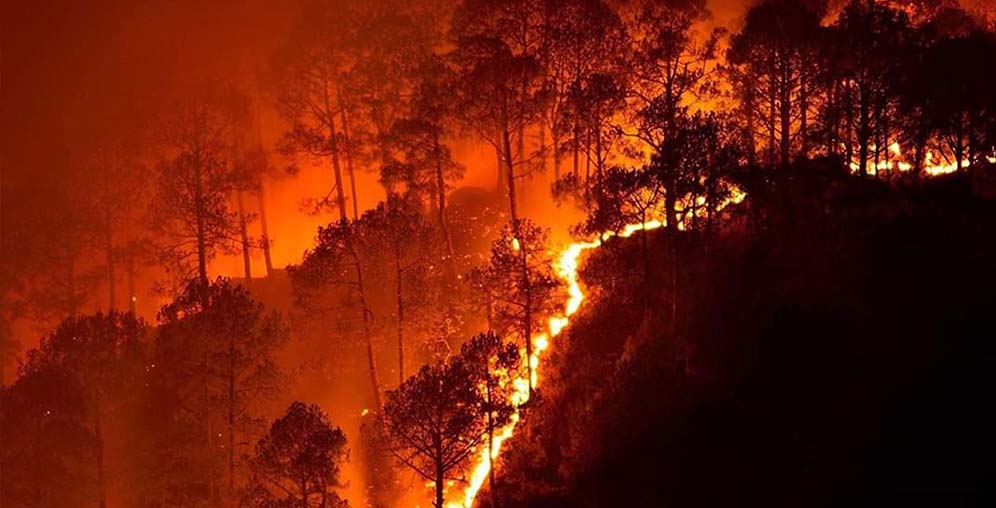[NEW DELHI] As wildfires become increasingly common with climate change, scientists are asking ‘how can forests be regrown quickly?’
Now researchers in India have identified a species of tree that they say could be ideal for replanting efforts.
The chinaberry tree, or Melia azedarach, can withstand flames well, due to its high heat tolerance, and is able to regenerate quickly following incidental fires, according to the study published in the journal Current Science.
Researchers say this makes if well-suited to planting in fire-affected areas for quick reforestation and regeneration — although experts also stress the need for a mix of species.
Sourav Mohapatra, assistant professor in the Department of Forest Biology and Tree Improvement at Odisha University of Agriculture and Technology and author of the study, told SciDev.Net: “[Chinaberry] is a robust, hardy, fast-growing species capable of withstanding adverse conditions and can readily regenerate when conditions improve.”
Moreover, following its rotation period of ten to 15 years, farmers can cut the trees and the harvested wood can be sold, says Mohapatra.
With forest fires increasing in India and around the world, there is an urgent need for effective planning and management for rehabilitation of degraded forest ecosystems to increase the green cover as quickly as possible.
This demands forest species that can resist forest fires or regenerate at a faster rate. They need to be fast growing, have a short rotation, and be resistant to insects and pests.
The researchers found that Melia trees possess these traits. However, the species can also colonise an area if left unchecked and is toxic to people and animals.
The large evergreen tree is native to India and grows wild in the sub-Himalayan region. It is prevalent in Odisha state, in the east of the country, and could be useful for its insecticidal and fungicidal properties.
It belongs to the Meliaceae (mahogany family) and is frequently confused with the Neem tree (Azadirachta indica). However, the structure of the leaves is different as well as the colour of the flowers, which are white in Neem and lilac in the chinaberry tree.
Fire resilience
According to the study, the Odisha University of Agriculture and Technology planted Melia trees in 2016 to increase green cover and enhance soil stability. But a natural forest fire in 2018 destroyed the two-year old trees.
Following the rainy season, however, trees that had been seriously burned began to recover, and in just two years, they had grown to a reasonable size and shape.

The 2019 wildfire in Bandipur National Park in Karnataka, India. With increasing fires in India and around the world, researchers say there is an urgent need for effective planning and management for rehabilitation of degraded forest ecosystems. Copyright Naveen Nkadalaveni. (CC BY-SA 4.0). This photo has been cropped.
The researchers also noted that on the burnt site in the Gajapati district of Odisha, only four per cent of the trees died. They concluded that the survival rate of Melia was significantly higher in adverse situations.
“Melia has the ability to rejuvenate faster than other trees,” Mohapatra said.
“Forest fires cause great damage to forest trees and it is necessary to select an appropriate species that can sustain itself under such environmental hazards.
“Melia could be the ideal choice for planting drives in such situations.”
K.N. Ganeshaiah, emeritus professor of the University of Agricultural Sciences, Bangalore says the species should be compared with other fast-growing trees before concluding that it is the best solution.
He also stressed that reforestation efforts should include a range of diverse species, rather than a single species.
“Such enhanced plant diversity is not only essential for maintaining ecological health and productivity but also promotes the diversity of non-target species in the area such as insects and birds,” Ganeshaiah said.
C. Kushalappa, a retired dean at the College of Forestry of the University of Agricultural and Horticultural Sciences Shivamogga, also struck a note of caution. He says Melia azedarach may not be suitable for all landscapes and agroforestry purposes.
“It is perhaps better suited to drier areas,” he said.
“In the southern parts of India, we see Subabul, or Leucaena leucocephala, as a gregarious tree that restores totally degraded forest areas in Karnataka,” he added.
“Also, Melia dubia [also known as Malabar Neem or Gora neem] is a more popular species grown in the drier areas of Karnataka in agroforestry.”
This piece was produced by SciDev.Net’s Asia & Pacific desk.




